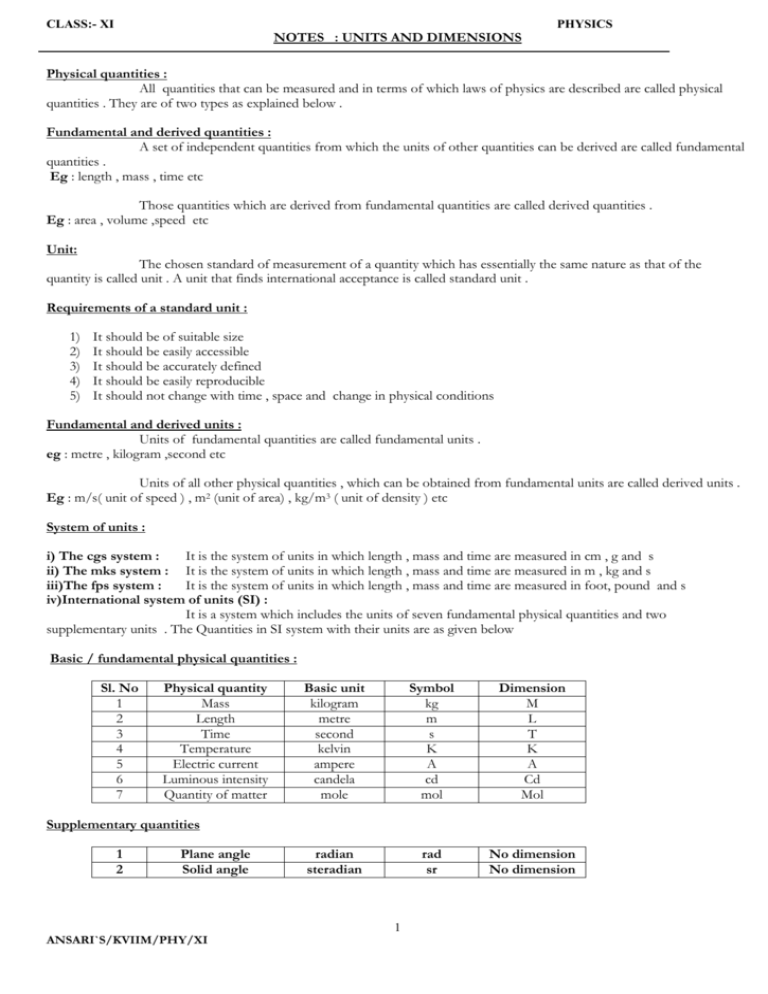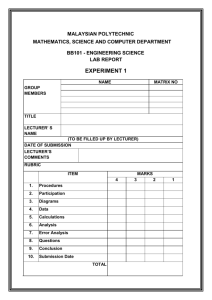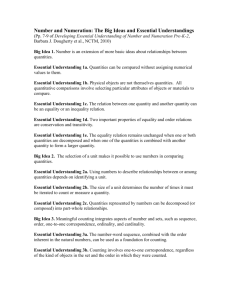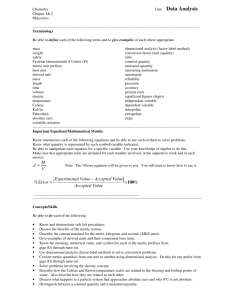class - e-CTLT
advertisement

CLASS:- XI PHYSICS NOTES : UNITS AND DIMENSIONS Physical quantities : All quantities that can be measured and in terms of which laws of physics are described are called physical quantities . They are of two types as explained below . Fundamental and derived quantities : A set of independent quantities from which the units of other quantities can be derived are called fundamental quantities . Eg : length , mass , time etc Those quantities which are derived from fundamental quantities are called derived quantities . Eg : area , volume ,speed etc Unit: The chosen standard of measurement of a quantity which has essentially the same nature as that of the quantity is called unit . A unit that finds international acceptance is called standard unit . Requirements of a standard unit : 1) 2) 3) 4) 5) It should be of suitable size It should be easily accessible It should be accurately defined It should be easily reproducible It should not change with time , space and change in physical conditions Fundamental and derived units : Units of fundamental quantities are called fundamental units . eg : metre , kilogram ,second etc Units of all other physical quantities , which can be obtained from fundamental units are called derived units . Eg : m/s( unit of speed ) , m2 (unit of area) , kg/m3 ( unit of density ) etc System of units : i) The cgs system : It is the system of units in which length , mass and time are measured in cm , g and s ii) The mks system : It is the system of units in which length , mass and time are measured in m , kg and s iii)The fps system : It is the system of units in which length , mass and time are measured in foot, pound and s iv)International system of units (SI) : It is a system which includes the units of seven fundamental physical quantities and two supplementary units . The Quantities in SI system with their units are as given below Basic / fundamental physical quantities : Sl. No 1 2 3 4 5 6 7 Physical quantity Mass Length Time Temperature Electric current Luminous intensity Quantity of matter Basic unit kilogram metre second kelvin ampere candela mole Symbol kg m s K A cd mol Dimension M L T K A Cd Mol radian steradian rad sr No dimension No dimension Supplementary quantities 1 2 Plane angle Solid angle ANSARI`S/KVIIM/PHY/XI 1 1) The metre : Definition of Fundamental and supplementary units of SI system One metre is defined as 1,650,763.73 times the wavelength in vacuum , of the radiation corresponding to the orange red light emitted by Kr - 86 atom during its transition between two levels Note : Wavelength of Kr - 86 is been chosen , as it is easily reproducible and it is not affected by time or variation of any other physical conditions 2) The kilogram : It is defined as the mass of a Standard block of Platinum Iridium alloy preserved in the international bureau of weights and measures near Paris . ( If the block is cylindrical , then height = diameter ) . 3) The second : One second is defined as the duration of 9,192,631,770 times the period of radiation corresponding to the transition between two hyperfine lines of the ground state of Cs - 133 atom . OR It is 1/86,400 times the duration of a mean solar day . 4) kelvin : It is defined as 1/273.16 times the triple point of water . ( Triple point of water is 273.16 K) 5) The ampere : One ampere is that constant current , which when maintained between two infinitely long straight conductors separated by a distance of 1 m in vacuum experiences a force of 2x10-7 N per metre length of the wire . 6) Candela : It is defined as the luminous intensity in a given direction due to a source , which emits monochromatic radiation of frequency 540x1012 Hz and of which the radiant energy in that direction is 1/683 watt/ steradian 7) mole : It is the amount of substance containing same number of elementary particles ( atoms / molecules /ions) as there are atoms in 12 g ( or 0.012 kg) of C -12 i) radian : It is the plane angle between the two radii of a circle , which cut off an arc of length equal to the radius from the arc . Note: We know ,angle = arc/radius . If arc = radius , then = 1 radian) ii) Steradian : It is the solid angle with its apex at the centre of a sphere that cuts out an area on the surface of the sphere equal to the area of a square , whose sides are equal to the radius of the sphere or area equal to square of the radius . Important practical units LENGTH : 1) Astronomical unit (AU) : It is the average distance between sun and earth . 1AU = 1.5 x 1011 m 2) Light year (ly) : Distance travelled by light in one year through vacuum , 1 ly= 9.46 x 1015 m 3) Parallactic second (Par sec) : The distance at which an arc of 1AU subtends an angle of 1 second . We know , angle = Substituting = 1 second = 4) arc L L r = . radius r 60 x 60 x180 rad and L = 1AU = 1.5x 1011 m , We get r ( or 1 parsec ) = 3.1x1016 m . ( Also 1 par sec = 3.26 ly ) 1micron() = 10-6 m , ANSARI`S/KVIIM/PHY/XI 2 MASS : 1) tonne/metric tonne = 1000 kg 2) 1 quintal = 100 kg 3) 1 atomic mass unit ( a m u / u ) : This is defined as 1/12 th of the mass of 1 C -12 atom = 1.66 x10-27 kg TIME: 1) Solar day : Time taken by earth to rotate once about its own axis w.r.t. sun = 24 hours 2) Solar year : Time taken by earth to complete one revolution around the sun in its orbit . 1 solar year = 365.25 solar days 3) Lunar month : The time taken by moon to complete one revolution around the earth 1 Lunar month = 27.3 days . Advantages of SI system i) It is a rational system ( ie in this system there is only one unit for one quantity) Eg : Any form of energy either mechanical / heat etc has same unit joule) ii) It is a coherent system: ie. All the derived units are obtained by dividing or multiplying the basic and supplementary units) such that no numerical factors are introduced iii) It is a metric system ie . Multiples and sub multiples can be expressed as the powers of 10. Prefixes for powers of 10 Power of 10 10-1 10-2 10-3 10-6 10-9 10-12 10-15 101 103 106 109 1012 1015 Prefix deci centi milli micro nano pico femto deca kilo mega giga tera peta Symbol d c m n p f da k M G T P Order of magnitude of a quantity It is the value of a quantity nearest to the actual value expressed in terms of powers of 10 . For this a number less than 5 is treated as 1 and between 5 and 10 is treated as 10 Generally to know the order of magnitude of a given quantity , the number is to be converted to a number between 0.5 and 5 multiplied by power of 10 . This power of 10 represents the order of magnitude of that quantity . Eg : (1) 501 can be expressed as 0.501 x103 , and hence the order is 3 . (2) 499 can be expressed as 4.99x102 and hence the order is 2 Indirect measurements of long distances Echo method : This method is based on the reflection of a probe wave (any wave send for detection) To find the distance (x) of an object from a source of probe wave , the wave is send to the object and the time taken by the wave to travel between the source and the object ( to and fro ) is determined as t . As speed = distance /time , distance can be determined as x= vt , where v is the velocity of the probe wave other than light . 2 Note: This method is employed in SONAR ( Sound Navigation And Ranging ) also . ANSARI`S/KVIIM/PHY/XI 3 Any electromagnetic wave such as light or radio wave can also be used as probe wave and as said above the distance ‘x’ can be determined as x= ct ( where c is the velocity of light ) 2 Note: This method is employed in RADAR ( Radio Detection And Ranging ), LASER ( Light Amplification by Stimulated Emission of Radiation ) etc Triangular method of determining the height of an object To determine the height (h) of a distant object , it is to be viewed form a point A at a distance (x) from the foot B of the object . If is the angle of elevation (angle that the top of the object makes with the point , measured from the ground ) , the height can be determined as follows (using figure I ) C h B A x figure-I tan = h x h = x tan To measure the height of an in accessible object on the side of a river etc… ( object whose x distance can't be measured directly ) , then the object is to be viewed from two points separated by x distance . Let 1 and 2 be the angles of elevation corresponding to the two points then from figure II figure-II BQ AQ and from BPQ cot 2 = PQ PQ ( BQ AQ) AB x cot 2 - cot 1 = = = PQ PQ h x h= (cot 2 cot 1) From triangle APQ , cot 1 = Determination of the size of an astronomical object For this the object ( say moon) is viewed from a point on earth with an astronomical telescope . Let the telescope makes an angle α with the diametrical ends of the object which is at a distance s from earth . Treating the diameter (d) of the object as the arc of the angle α at distance s , then α = d s d = s α ( refer figure III) Note : 1) The angle() subtended by two diametrically opposite ends of an astronomical object at a point on earth ANSARI`S/KVIIM/PHY/XI 4 figure-IV figure-III is called angular diameter of the object . 2) Angle α should always be treated in radians Determination of distance of a distant object from a point Parallax method : Parallax is the change in position of an object with respect to the back ground , when the object is viewed from tow different observation points. The angle that a distant object subtends at two different observation points is called parallax angle OR parallactic angle () and the distance between the observation points is called the basis (b) . By knowing the values of and b , the distance (D) of the distant object can be calculated as = b D D = b ( refer figure IV) But as simultaneous observation of an object from two points on earth is impossible , we select a very distant star , whose position from different points on earth stands fixed . The distance of any astronomical object can be measured on the basis of this star as follows . Let the object under consideration makes angles 1 and 2 with the distant star from two different positions of earth as in figure , then = 1+ 2 and hence D = b b = ( 1 2 ) ( Refer figure V) Note : Usually in the second method earth's position ( observation points ) will be two diametrically opposite points in its orbit during its motion around Sun , which is b = 2 AU Dimensional Analysis Dimension : Dimensions of a physical quantity are the powers to which the fundamental units of mass, length and time are to be raised to represent a derived unit of the quantity . Eg Dimension of length in area is 2 ( A = L2 ) Dimensional formula : Dimensional formula of a physical quantity is the expression that indicates which of the fundamental units ( L,M , T etc) enter into the derived unit of that quantity and with what powers . ANSARI`S/KVIIM/PHY/XI 5 Dimensional equation : An equation that gives the relation between a physical quantity and its dimensional formula is called dimensional equation Eg : In the dimensional equation of the form F = MLT-2 , -2 is the dimension of time in force , as it is the power MLT-2 is called dimensional formula of force and F = MLT-2 is called dimensional equation of force . Note : 1) Quantities like velocity , area etc are variables having dimension and hence are called dimensional variables 2) Quantities like angle , strain etc are variables having no dimension and hence are called dimensionless variables 3) Quantities like gravitational constant , Plank's constant are constants having dimension and hence are called dimensional constants 4) Quantities , numbers like 1,2,3etc are constants having no dimension and hence are called dimensionless constants Principle of homogeneity : It states that, dimensions of all the terms on either side of an equation are the same Uses of dimensional analysis 1) To check the correctness of the equation This is done on the basis of principle of homogeneity of dimensions . Eg . To check if the equation ½ mv2 = mgh is dimensionally correct , then take the dimensions on either side and check the equality in dimension of each term on either side . If they are same on either side , equation is dimensionally correct . 2) Conversion of one system of units in to another Any measured quantity can be written as , Q = n1u1 = n2u2 , where u1 and u2 are units in different systems . n2 = a b But u1 = M 1 L1 T1 c n1u1 u2 a b and u2 = M 2 L2 T2 c M :. n2 = n1 1 M2 a L1 L2 b T1 T2 c 3) Derive the relation between different physical quantities . This also is based on principle of homogeneity of dimensions . Important note : During mathematical operations ,only quantities having identical dimension can be added or subtracted and the result will also be having dimension as the same quantities [ L + L = L (dimensionally )]. But multiplication and division is possible between quantities of different dimensional formula . Limitations of dimensional analysis : 1) It does not help you to determine the value of the constant of proportionality 2) It can not be used to derive composite relations ( relations having more than one term ) 3) It can not be used to derive relations where trigonometric or exponential functions are involved 4) It fails to derive a relation when a physical quantity depends upon more than three physical quantities . Errors in measurements Significant figures : The number of digits in which we have confidence in a measurement . More the number of significant figures , greater is the accuracy of the measurement . Rules for counting significant figures : a) b) All non zero digits are significant . (eg : 1567 has four S . F) All zeroes between two non zero digits are significant ( eg : 10072 has five S.F ) ANSARI`S/KVIIM/PHY/XI 6 c) d) e) f) g) For decimal numbers ( ie for number less than one ) all zeros to the right of decimal point and left of non zero digit are not significant . ( eg 0.0097 has two S.F only ) All zeroes to the right of the last non zero digit in the decimal part are significant ( eg 0.009700 has 4 S.F because the last two zeros are significant though first two are not) All zeroes to the right of non zero digit are not significant ( eg : 2000 has only one S.F ) All zeros on the right of the last non zero digit will be significant , when they come from a measurement . (eg . 5630 m has four S.F ) When some value is expressed in exponential form , the exponential term does not affect the number of significant figures ( eg: 54.4 = 5.44x101= 0.544x102 = 544x10-1 . In all cases there are only three S.F) Important note : Change in units of measurement of a quantity does not change the number of S.F Eg : 200 cm has three S.F, 2.00 m also has three S.F . Also 300 has only one S.F 3x102 also has 1 S.F Rounding off Rules : a) If the digit to be dropped is less than 5 , the preceding digit is left unchanged (eg : 8.54 is rounded off to 8.5 ) b) If it is more than 5 , then the preceding digit is raised by one (e.g : 6.86 is rounded off to 6.9) c) If the digit to be dropped is 5 followed by digits other than zero , then the preceding digit is raised by one . (eg : 23.351 is rounded off to 23. 4 ) d) If the digit to be dropped is 5 or 5 followed by zero , then the preceding digit is left unchanged if it is even . (eg : 5.450 is rounded off to 5.4) e) If the digit to be dropped is 5 or 5 followed by zero , then the preceding digit is raised by one if it is odd . (eg : 5.550 is rounded off to 5.6) Mathematical operations with Significant figures 1) In addition and subtraction : The number of decimal places in the result should be same as the smallest number of decimal places of terms in the operation . (eg : 34.56 + 2.5 = 37.06 . As the least decimal place is one , the answer is 37.1 ) 2) In multiplication and division : The number of significant figures in the result is same as the smallest number of significant figures in any of the factors . (e.g : (3.8) x (0. 125) = 0. 475 . As the least significant figure is two , the answer is 0.48 ) Errors Absolute error : The magnitude of the difference between the true value and the measured value of the quantity . ( arithmetic mean of all the measurements is taken as true value a ) . Note : Absolute error in 'a' is written as a Mean absolute error : It is the mean of the absolute errors in all the measurements . It is represented as a Relative error : It is the ratio of mean absolute error to the mean value of the quantity measured . ie Relative error expressed in % is called percentage error . ie Relative percentage error in a is a x100 a Combination of errors ANSARI`S/KVIIM/PHY/XI 7 a a a) In sum and difference , the maximum absolute error in the result is the sum of the absolute errors in the individual quantities . Eg : If a = b + c OR a =b-c then ∆a = ∆b + ∆c b) In multiplication and division , the maximum relative error in the result is the sum of the relative errors in the individual quantities . Eg : If a = b x c c) OR a = b /c , a b c a b c The relative error of a quantity raised to power n is n times the relative error in the quantity . a b n a b a b p q For an equation given below , that covers rules ( ii ) & ( iii) y then the maximum possible error in y is rc y p q r a b c y p q r Eg : If a = b n d) then then Note: To get maximum % relative error , multiply each side of the above equation by 100 Some more important points i) The numerical value of density in S.I system is 103 times the value in c.g.s system . ii) Inertia has the dimension of mass . iii) Work , energy , heat , potential energy , kinetic energy , internal energy ,torque , couple , moment of force etc have identical dimensional formula , M1L2T-2 iv) The dimensional formula for frequency , angular frequency , angular velocity and velocity gradient etc has identical dimensional formula , M0L0T-1 v) Strain , angle , solid angle , trigonometric ratios , refractive index , relative density , relative permittivity and relative permeability etc have no dimensions vi) Thermal capacity gas constant , Boltzmann constant and entropy have same dimensions and is M1L2T-2K-1 vii) Exponential functions are not having dimensions . (Eg : If a function is of the form ekx, then term kx is dimensionless ) ANSARI`S/KVIIM/PHY/XI 8





